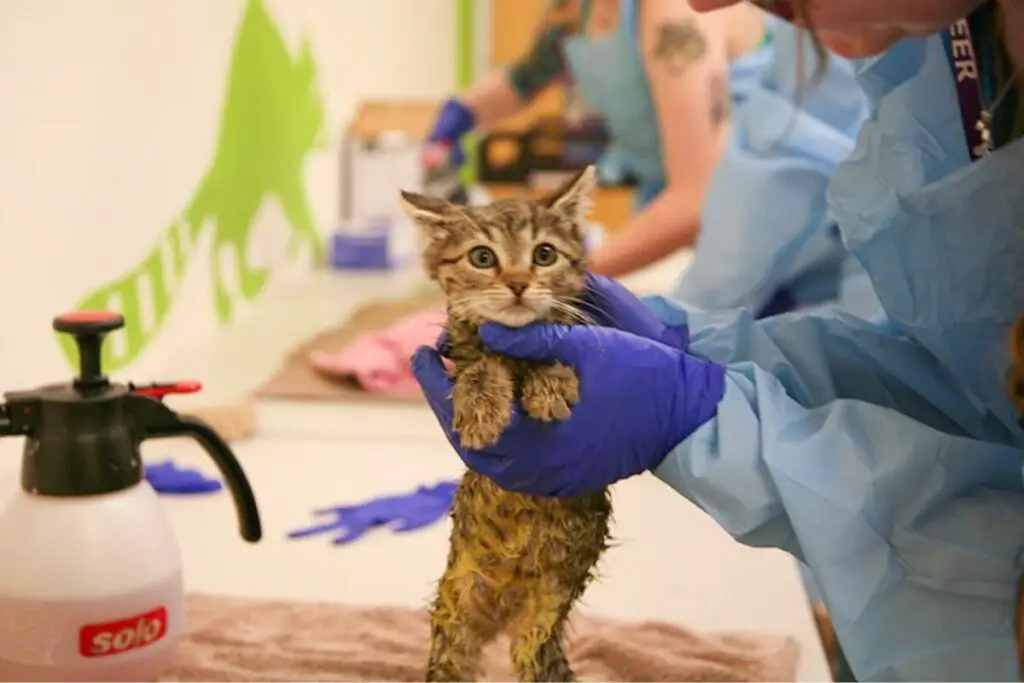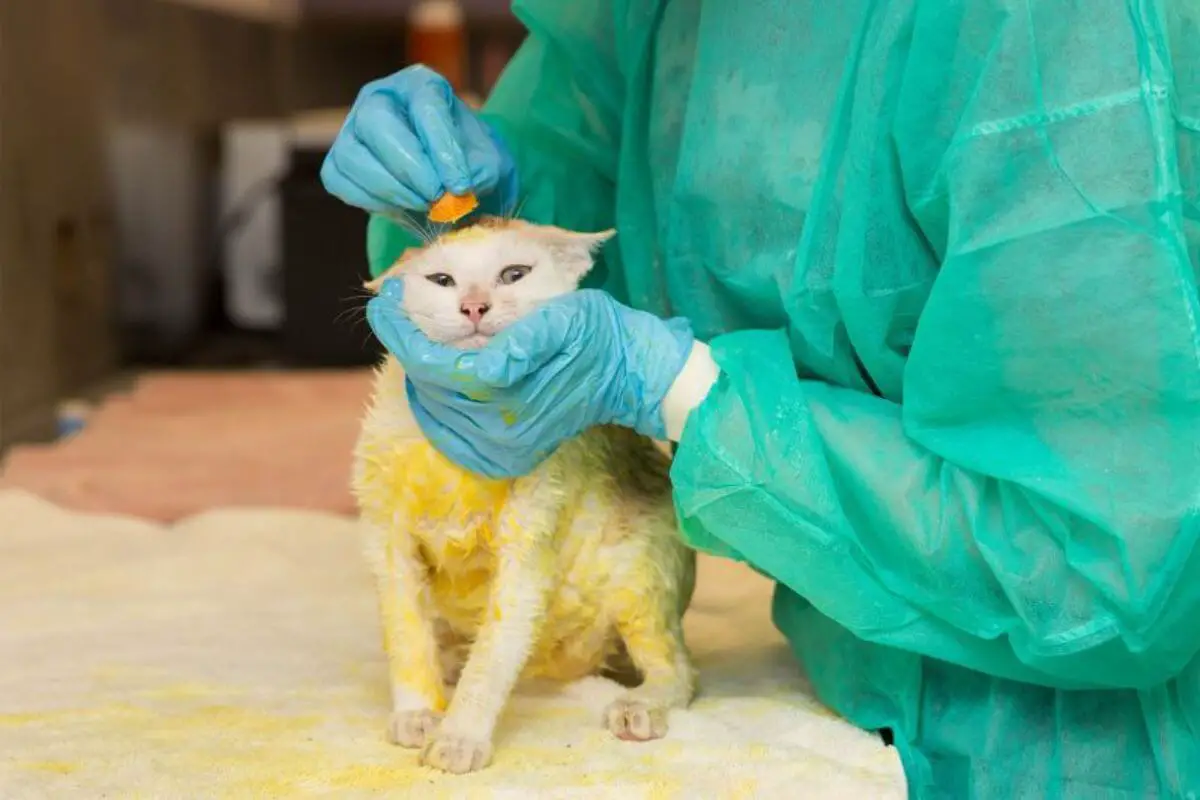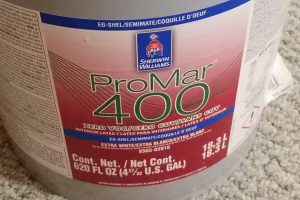A lime sulfur dip is a treatment that’s often used for cats with certain skin conditions, such as ringworm or mange. While it can be an effective solution for these issues, it’s crucial to understand when and how to bathe your cat after a lime sulfur dip. This comprehensive guide will walk you through the process, ensuring your feline friend remains clean, comfortable, and healthy.
Understanding the Lime Sulfur Dip
The lime sulfur dip is a distinctive and effective treatment used in veterinary medicine to address certain skin conditions in cats. This treatment has a history dating back several decades and has been a go-to solution for ailments such as ringworm and various types of mange. Understanding the lime sulfur dip is essential for cat owners and caregivers to provide the best care for felines experiencing skin issues.
What Is Lime Sulfur Dip?
The lime sulfur dip, sometimes referred to simply as “sulfur dip” or “lime dip,” is a liquid solution containing sulfur in the form of calcium polysulfides. It is known for its distinctively pungent odor and its medicinal properties. When applied to a cat’s skin, this solution works as an antimicrobial, antiparasitic, and antifungal agent. Lime sulfur dip is especially effective against fungal infections like ringworm and mites causing mange.
Common Uses of Lime Sulfur Dip
Lime sulfur dip is typically used to treat the following conditions in cats:
Ringworm:
Ringworm is a contagious fungal infection that can affect a cat’s skin, fur, and occasionally their nails. Lime sulfur dip is an effective treatment for ringworm, helping to eliminate the fungal infection.
Mange:
Mange is a skin condition caused by mites. Lime sulfur dip is used to kill these mites and alleviate the symptoms associated with mange.
Folliculitis:
Folliculitis is an inflammation of the hair follicles. Lime sulfur dip can be used to treat this condition, as it has antibacterial properties.
Other Fungal and Bacterial Infections:
Lime sulfur dip may also be recommended for various other skin infections caused by fungi or bacteria.
The Application Process
The application of lime sulfur dip typically involves the following steps:
Wearing Protective Gear:
The person applying the dip should wear gloves and protective clothing, as the solution can stain skin and fabrics.
Preparation:
The lime sulfur dip solution is prepared according to the veterinarian’s instructions, as the concentration may vary.

Bathing:
The cat is bathed with the lime sulfur dip solution. It’s important to ensure the solution is thoroughly worked into the fur and reaches the skin.
Drying:
After the bath, the cat is allowed to air dry. Avoid rinsing the solution off, as it continues to work on the skin.
Potential Side Effects
Lime sulfur dip is generally safe when used as directed by a veterinarian. However, there can be side effects, including:
Skin Dryness:
The dip can cause temporary dryness and irritation of the skin.
Staining:
The solution can stain the fur and fabrics it comes into contact with.
Odor:
The strong odor of the sulfur can linger for a period after treatment.
Post-Dip Baths
Bathing a cat after a lime sulfur dip is a common practice to remove any lingering odor and to keep the cat’s fur clean. This is typically done according to the veterinarian’s instructions, and it’s important to follow their guidance closely.
In conclusion, understanding the lime sulfur dip is vital for cat owners and caregivers dealing with specific skin conditions. It’s a valuable treatment option for various ailments, and when used correctly, it can help alleviate these conditions and restore your cat’s skin health. Always follow your veterinarian’s recommendations for the best results and to ensure your cat’s safety and well-being.
When to Bathe Your Cat After a Lime Sulfur Dip
The timing of the post-dip bath can vary depending on your veterinarian’s recommendations and your cat’s individual needs. Here are some general guidelines to consider:
1. Follow Your Veterinarian’s Advice
Your veterinarian will provide specific instructions regarding the frequency and timing of post-dip baths. It’s essential to follow their guidance closely, as they are familiar with your cat’s condition and how it’s responding to treatment.
2. Typically, Wait 24-48 Hours
In many cases, it’s recommended to wait 24 to 48 hours after the lime sulfur dip before bathing your cat. This allows the medication to work on the skin and ensures its effectiveness. However, the exact waiting period can vary based on the specific treatment plan.
3. Monitor Your Cat’s Condition
Your cat’s response to the lime sulfur dip can influence when you should bathe them. If the skin condition is improving and your cat is comfortable, you may not need to bathe them as frequently. Conversely, if the condition persists or worsens, your veterinarian may recommend more frequent baths.
How to Bathe Your Cat After a Lime Sulfur Dip
When the time comes to bathe your cat post-dip, follow these steps to ensure a safe and effective process:
Bathing your cat after a lime sulfur dip is an essential part of the treatment process for various skin conditions. It’s crucial to follow specific steps to ensure that your cat remains clean, comfortable, and the treatment is effective. Here’s a step-by-step guide on how to bathe your cat after a lime sulfur dip:
1. Gather the Necessary Supplies
Before you begin, gather all the essential supplies. You will need:
- Mild cat shampoo: Choose a cat-specific shampoo that is gentle on your cat’s skin and free from harsh chemicals.
- Lukewarm water: Fill a basin or sink with lukewarm water to a comfortable depth for your cat. Make sure it’s not too deep to prevent your cat from feeling anxious.
- Towel: Prepare a clean, dry towel for drying your cat after the bath.
- Cat brush: Have a cat brush on hand to help remove tangles and mats from your cat’s fur.
2. Prepare the Bathing Area
- Choose a warm, quiet, and draft-free room for the bath. This environment will help keep your cat calm during the process.
- Place a towel or non-slip mat at the bottom of the sink or basin. This will provide a secure surface for your cat to stand on.
3. Wet Your Cat
- Gently wet your cat’s fur, excluding the face. Use a handheld spray nozzle or a cup to pour water over your cat. Be cautious and avoid causing stress to your pet.
4. Apply the Shampoo
- Apply a small amount of mild cat shampoo to your hands and create a lather. Be gentle while working the shampoo into your cat’s fur, ensuring it covers all areas.
5. Rinse Thoroughly
- Rinse your cat thoroughly to remove all the shampoo from their fur. Leftover shampoo residue can irritate your cat’s skin.
6. Pat Dry
- After the bath, use a clean, dry towel to pat your cat dry. Be gentle and ensure the room is warm to prevent your cat from getting chilled.
7. Brush Your Cat
- Once your cat is dry, use a cat brush to help remove any tangles or mats from their fur. Brushing also provides a calming and bonding experience for you and your cat.
8. Post-Bath Comfort
- After the bath, ensure your cat is comfortable and relaxed. Offer some treats, play with your cat, or provide a cozy spot for them to rest.
9. Follow Veterinarian’s Recommendations
- Always follow your veterinarian’s recommendations regarding the timing and frequency of post-dip baths. Your vet will provide specific instructions based on your cat’s condition.
10. Monitor Your Cat
- Keep a close eye on your cat’s condition and how they respond to the treatment. If you notice any adverse reactions or worsening of the skin condition, contact your veterinarian for guidance.
In conclusion, bathing your cat after a lime sulfur dip is a critical part of the treatment process for various skin conditions. By following these steps and ensuring a calm and secure environment, you can make the post-dip bath as stress-free and effective as possible for your feline companion. Always consult your veterinarian for specific instructions and guidance based on your cat’s unique needs.
Additional Tips for Bathing Your Cat
- Ensure a quiet, calm environment for the bath to minimize stress.
- Use treats and positive reinforcement to reward your cat for their cooperation during and after the bath.
- If your cat is particularly distressed during baths, consult your veterinarian about sedation or alternative treatments.
In conclusion, bathing your cat after a lime sulfur dip is a crucial step in the treatment process for certain skin conditions. Following your veterinarian’s guidance and maintaining a gentle and patient approach during the bath will help ensure the best results for your cat’s health and comfort. If you have any concerns or questions about the bathing process, don’t hesitate to reach out to your veterinarian for further assistance.
Frequently Asked Questions (FAQs) About Bathing Your Cat After a Lime Sulfur Dip
Bathing your cat after a lime sulfur dip is a specific process that may raise several questions. Here are some common FAQs to provide you with a more comprehensive understanding of this essential procedure:
1. How do I know when it’s time to bathe my cat after a lime sulfur dip?
The timing for post-dip baths varies depending on your veterinarian’s recommendations and your cat’s response to treatment. Your veterinarian will specify when and how often to bathe your cat as part of the treatment plan. It’s crucial to adhere to their instructions closely.
2. Can I use regular cat shampoo for the post-dip bath?
Using regular cat shampoo is generally fine for the post-dip bath. However, it’s essential to choose a mild and gentle cat shampoo that won’t irritate your cat’s skin. Avoid using harsh or heavily scented shampoos, as they can be too harsh for sensitive skin.
3. Is it normal for my cat to dislike baths?
Many cats are not fans of water and may show resistance during bath time. It’s essential to approach baths with patience and gentleness. Using positive reinforcement, treats, and creating a calm environment can help make the process more manageable and less stressful for your cat.
4. Can I bathe my cat at home, or should I seek professional help?
You can bathe your cat at home after a lime sulfur dip, following your veterinarian’s recommendations. However, if you feel uncomfortable or your cat is particularly distressed during baths, consulting a professional groomer or your veterinarian for assistance is a viable option.
5. How can I make the post-dip bath experience less stressful for my cat?
Creating a calming and secure environment is crucial for reducing stress during baths. Ensure the room is warm and draft-free, use a non-slip surface for your cat to stand on, and maintain a gentle and reassuring tone throughout the process. Using treats and positive reinforcement can also help your cat associate baths with positive experiences.
6. What should I do if my cat’s skin condition worsens after the lime sulfur dip and baths?
If your cat’s skin condition worsens after the lime sulfur dip and baths, or if you notice any adverse reactions, contact your veterinarian immediately. They can reassess the treatment plan and recommend any necessary adjustments or alternative treatments.
7. How can I prevent future skin issues in my cat?
Preventing skin issues in your cat involves regular grooming, a balanced diet, and routine check-ups with your veterinarian. Keeping your cat’s fur clean and free of tangles can help prevent skin problems. Additionally, consult with your veterinarian to address any underlying health issues that may contribute to skin conditions.
In conclusion, bathing your cat after a lime sulfur dip is a critical step in treating certain skin conditions. By following your veterinarian’s guidance, using gentle cat shampoo, and ensuring a stress-free environment, you can make the process more comfortable for your feline friend. If you have any concerns or questions about the procedure, don’t hesitate to reach out to your veterinarian for assistance and clarification.



